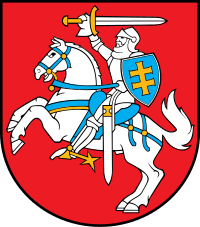Lithuanian Railways
|
| |
.jpg) | |
| Group of public companies | |
| Industry | Rail transport |
| Founded |
1860 (First Line) 1919 (Official) |
| Headquarters | Vilnius, Lithuania |
Key people | Stasys Dailydka, General Manager |
| Products | Rail transport, Cargo transport, Services |
| Revenue | €0.5 billion (2014)[1] |
| €0.1 billion (2007) | |
| €0.05 billion (2007) | |
| Total equity | €1.0 billion (2015)[2] |
| Owner | The Lithuanian state |
Number of employees | 10,505 (2011) |
| Website | Official Site |
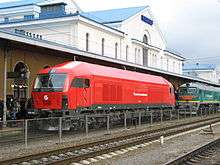
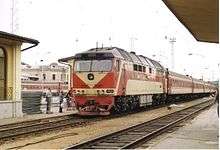
Lithuanian Railways (Lithuanian: Lietuvos geležinkeliai) is the national, state-owned railway company of Lithuania. It operates most railway lines in the country.
Lithuanian Railways' main network consists of 1749 km of 1,520 mm (4 ft 11 27⁄32 in) broad gauge railway of which 122 km are electrified. They also operate 22 km of standard gauge line and a new ~100 km standard gauge line is under construction at the moment alongside the broad gauge from Šeštokai to Kaunas.[3] A 179 km 750 mm (2 ft 5 1⁄2 in) narrow gauge network, listed as an object of cultural heritage, was split off into a separate company Aukštaitijos Siaurasis Geležinkelis in 2001. 68 km of narrow gauge, serving five stations, are regularly used, employing 12 locomotives.
In 2006 Lithuanian Railways transported 6.2 million passengers and 50 million tonnes of freight. Oil is the main freight item carried.[4]
History
In 1851, the government of Russia made the decision to build the Warsaw – Saint Petersburg Railway. The line included a stretch from Daugavpils–Vilnius–Kaunas–Virbalis which was started in 1858 and finished in 1860. When the German army occupied Lithuania in 1915, the railway became the main supplier of food stuff and ammunition for the German army. In 1918 Lithuanian independence was restored, and in 1919 the Lithuanian government concluded an agreement with Germany on the handover of the railway assets to the Ministry of Transport.
During the years after World War I, Lithuanian Railways reconstructed the tracks, connecting them into a complete network. In 1923 the Klaipėda region was annexed by Lithuania and the port of Klaipėda became a part of the Lithuanian railway system. In 1940 the USSR occupied Lithuania, and railway activities were reorganized and all the agreements of Lithuania concluded with the neighbouring countries were terminated. In 1941, the Nazi occupying force changed most of the network from broad gauge to standard gauge. This was changed back by Soviets in 1944. During Soviet times all of the Baltic states railways were managed from Riga. In 1991, the railways of the Baltic region were once again divided into separate railway companies.[5]
Rolling stock
.jpg)
Locomotives and trainsets for use on Lithuanian Railways' main network (excluding Panevezys-Rubikiai narrow gauge line) include:[6]
Passenger Locomotives
| Class | Manufacturer | Year(s) built | Year(s) withdrawn | Number built | Traction | Image |
|---|---|---|---|---|---|---|
| TEP60 | Kolomna Locomotive Works[7] | 1960 | 2011 | 12 | Diesel |
|
| TEP70 | 1987 | Still in service | 4 |
| ||
| TEP70BS | 2006 | 4 | .jpg) |
Freight Locomotives
| Class | Manufacturer | Year(s) built | Year(s) withdrawn | Number built | Traction | Remarks | Image |
|---|---|---|---|---|---|---|---|
| M62 | Voroshilovgrad Locomotive Works | 1970 | Still in service | 40 | Diesel | Subclass M62K have new engines. | 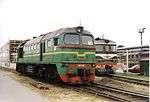 |
| 2M62 | 1976 | 74 | Twin-section version of M62. Locomotives 2M62-0001 to 2M62-0752 are equipped with M62 headlights, 2M62-0756 or later are equipped with DM62 headlights, 2M62-565 or later is equipped with new snowploughs. Subclasses 2M62K and 2M62M have new engines. | 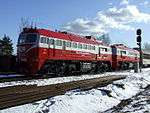 | |||
| 2M62U | 1987 | 22 | Updated version of 2M62 based on newer DM62 design. Snowplough and headlights are the same as later 2M62 have. They are also equipped with new fuel tanks and bogies without axle-box. Subclass 2M62UM have new engines. | ||||
| ER20 | Siemens | 2007 | 44 |  |
Shunters
| Class | Manufacturer | Year(s) built | Year(s) withdrawn | Number built | Traction | Remarks | Image |
|---|---|---|---|---|---|---|---|
| ČME3 | ČKD | 1964 | Still in service | 36 | Diesel | ||
| ČME3M | 2008 | 23 | Rebuilt ČME3 units. | | |||
| TEM-TMH | Bryansk Locomotive Works | 2009-2015 | 61 |  | |||
| TEM-LTH | 2013 | 1 | .jpg) |
Diesel Multiple Units
| Class | Manufacturer | Year(s) built | Year(s) withdrawn | Number built | Traction | Remarks | Image |
|---|---|---|---|---|---|---|---|
| D1 | Ganz Works | 1963 | 2013 | 24 | Diesel | In 4-car formation. | .jpg) |
| DR1A | Rīgas Vagonbūves Rūpnīca | 1973 | Still in service | 5 | In 5- and 6-car formations. Based on earlier DR1P. Two different shapes of nose were built in different time (the newest one is shown here). Example of older nose shape could be found at DR1AM line in this table. | 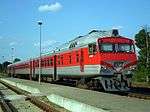 | |
| DR1AM | 1973 | 12 | 3-car formation adapted from DR1A. Equipped with new driving trailer cariages converted from trailer cariages in 1990s, the same conversions have been also made in other countries (named as DR1AM in Latvia/Ukraine/Georgia, DR1B/DR1BJ in Estonia, DRL1/MDP in Belarus). | .jpg) | |||
| AR2 | 1997 | 1 | 1-car Railbus. | | |||
| RA2 | Metrovagonmaš | 2008 | 4 | In 2- and 3-car formations. |  | ||
| 620M | Pesa | 2009 | 12 | 1-car railcar based on DR1A design. | | ||
| 630M | 2013 | 3 | In 2-car formation. | 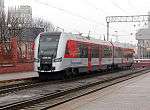 | |||
| 730ML | 2016 | 7 | In 3-car formation. | 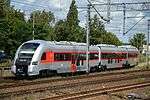 |
Electric Multiple Units
| Class | Manufacturer | Year(s) built | Year(s) withdrawn | Number built | Traction | Remarks | Image |
|---|---|---|---|---|---|---|---|
| ER9M | Rīgas Vagonbūves Rūpnīca | 1976 | Still in service | 12 | Electric | In 4-car formation. | |
| EJ575 | Škoda Transportation | 2008 | 10 | In 2- and 3-car formations. | |
Network
Electrification
Lithuania has chosen to electrify using 25 kV 50 Hz AC. Electrification is used only for commuter traffic between Vilnus and Kaunas, and on a short commuter branch. Electrification towards Belarus Molodechno station is being built as of 2016.

Rail links with adjacent countries
- Belarus
- Kaliningrad (Russia)
- Latvia
- Poland - break-of-gauge, 1,520 mm (4 ft 11 27⁄32 in) / 1,435 mm (4 ft 8 1⁄2 in)
See also
- Rail Baltica
- Transport in Lithuania
- Vilnius Metro
- Vilnius Intermodal Terminal
- Kaunas Intermodal Terminal
References
- ↑ http://www.litrail.lt/veiklos-ataskaitos
- ↑ name=http://vz.lt/rinkos/2015/10/14/vertingiausios-baltijos-saliu-imones-sarase-trys-is-lietuvos
- ↑ The line was scheduled to be finished by the end of 2015. See Rail Baltica project page for more details
- ↑ Railway Operations in Lithuania
- ↑ The History Pages of Lithuanian Railways
- ↑ "LG locomotives and trainsets". 2014-12-12. Retrieved 22 March 2015.
- ↑ "History: 1959-1977". kolomnadiesel.com. PJSC Kolomensky Zavod. Retrieved 24 March 2015.
External links
- Official website, in English, Russian and Lithuanian
- Winchester, Clarence, ed. (8 November 1935), "Estonia and Lithuania", Railway Wonders of the World, pp. 1292–1298, an account of the railways of Estonia and Lithuania in the 1930s
| Wikimedia Commons has media related to Lithuanian Railways. |

